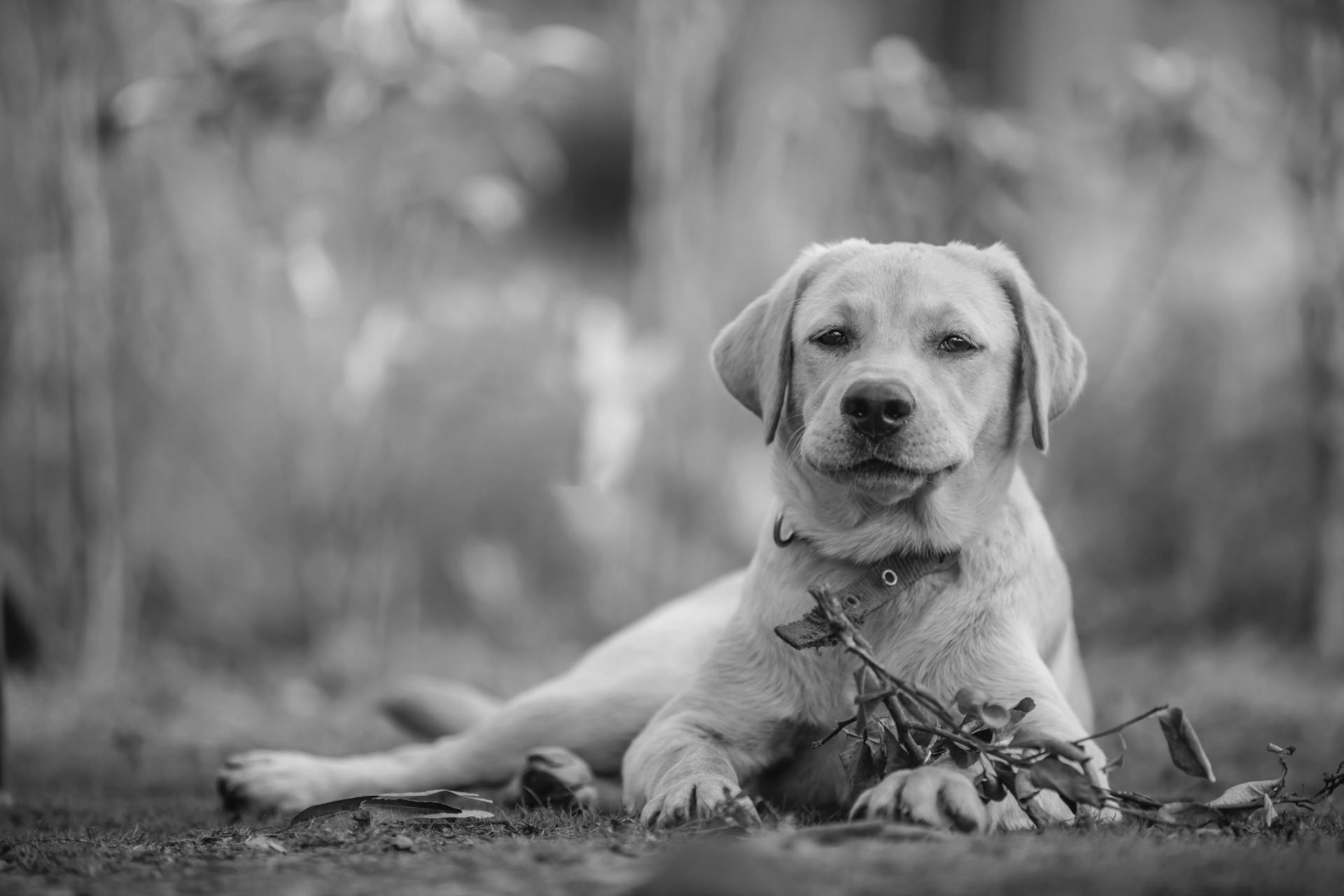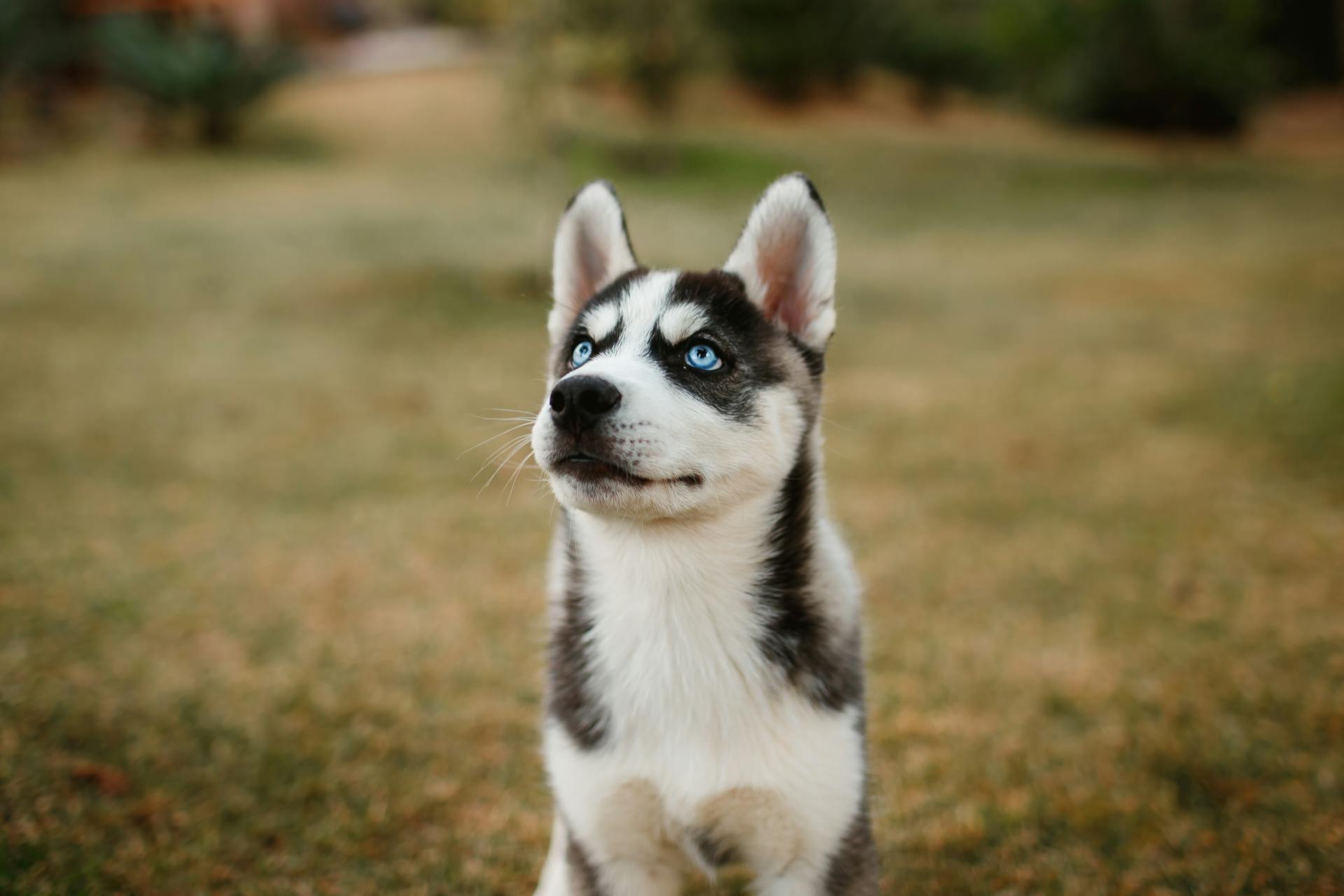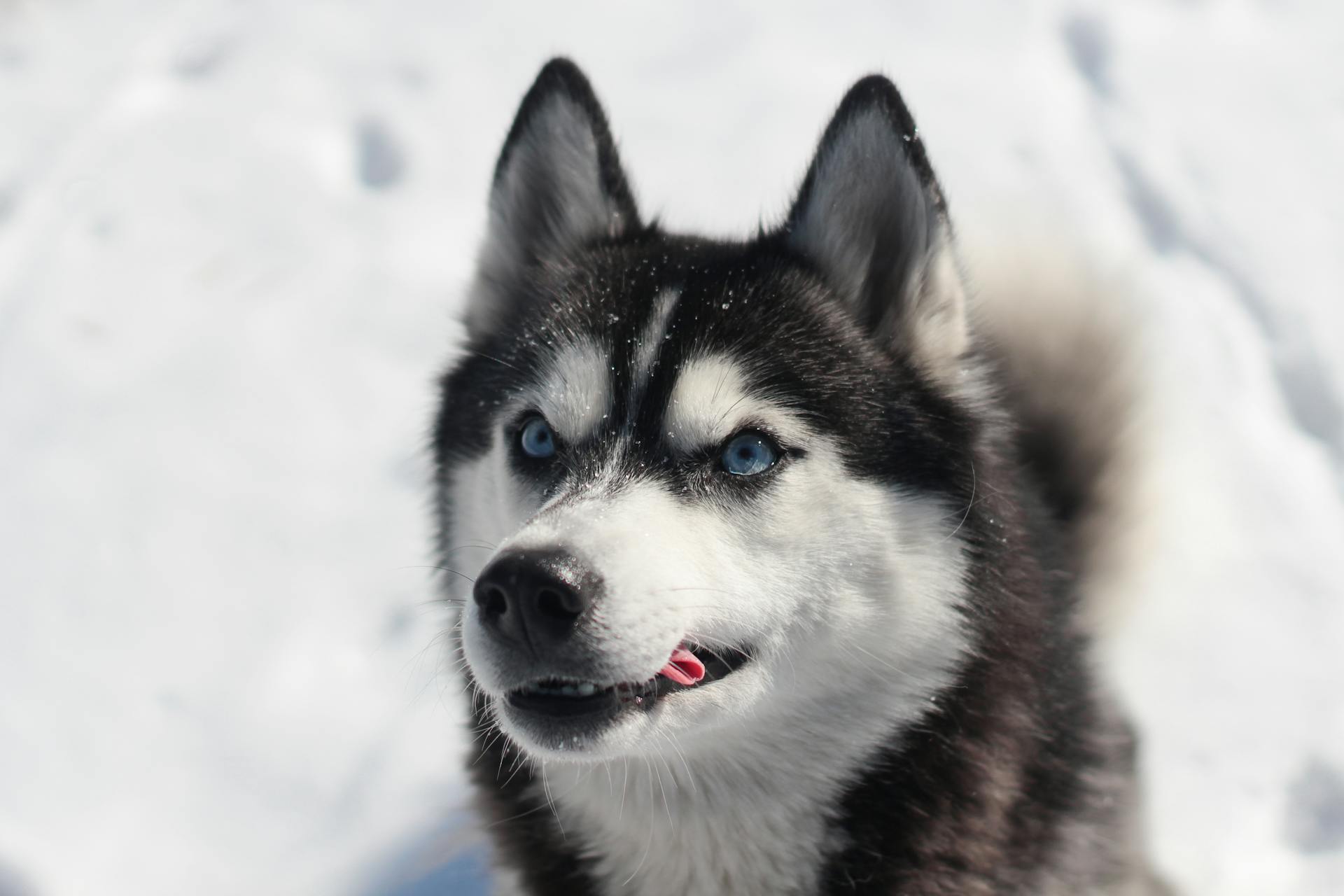
Husky Lab mix puppies are a bundle of energy and joy, requiring regular exercise to keep them happy and healthy. Aim for at least 30 minutes of playtime and physical activity per day.
As a breed that thrives on interaction, Husky Lab mix puppies need plenty of attention and socialization from an early age. This can be as simple as playing with them, going for walks, or even just cuddling on the couch.
To keep your Husky Lab mix puppy's coat in top condition, brush them at least twice a week to prevent matting and tangling.
Getting a Husky Lab Mix Puppy
Choosing a puppy should entail a more serious consideration than just picking the cutest one. You should also think about its health and what gender and temperament are best for you and your lifestyle.
The first step to getting the best dog for you is to find the right breeder. Look for legitimate, ethical, and caring breeders who will treat their dogs with respect and care.
A different take: Best Dog Breed Crosses
Request a tour of the breeder's kennel to see if it's safe and clean. Ask questions about what they're feeding their dogs, whether they have space for the dogs to run around and socialize, and verify that the puppies have been properly vaccinated.
Consider the dog's coat. If you live in a warm region, a shorter-haired dog is a more compassionate choice, as they won't have to suffer from the heat.
Observe the puppies' temperament. Look for a puppy that's curious, outgoing, friendly, and brave enough to approach you on their own.
Here are some tips for choosing a Husky Lab mix puppy:
- Inspect the puppy's eyes, ears, mouth, skin, underbelly, tail, and paws to make sure they're clean and healthy looking.
- Request information about the parent breeds' health history and any genetic testing done to check for congenital health problems.
- Ask for the name of the breeder's veterinarian and double-check with them.
Do your research and look for trustworthy breeders like Lancaster Puppies and Greenfield Puppies.
Characteristics and Traits
A Husky Lab mix puppy is a bundle of energy and love, with a unique set of characteristics that make them a wonderful companion. They typically weigh between 40 to 60 pounds, with males ranging from 40 to 60 pounds and females from 40 to 55 pounds.
Their height varies, with males reaching 21 to 25 inches and females 20 to 24 inches. This large size requires plenty of exercise and space to run around. A Husky Lab mix has a double coat, which is short to medium in length, and sheds moderately, especially during shedding season.
Their coat color can be a mix of black, brown, red, white, yellow, or any combination of these colors. Their eyes are either blue or brown, and their nose is dark. Their ears are down, and they have a playful, affectionate, and loyal temperament.
A Husky Lab mix is intelligent and requires lots of mental stimulation to keep them happy and engaged. They need access to a large space where they can run and play freely, and owners who work all day should consider hiring a pet walker or arranging for a friend to take them to the park.
Here's a summary of the key characteristics of a Husky Lab mix:
Overall, a Husky Lab mix is a loving and loyal companion that requires attention, exercise, and mental stimulation to thrive.
Grooming
Grooming your Husky Lab mix puppy is a significant commitment, but with the right routine, you'll be rewarded with a happy and healthy furry friend. They shed regularly throughout the year, but be prepared for prime shedding seasons in spring and autumn.
You'll need to brush your dog twice a week to manage the shedding, and an undercoat rake will make this task more manageable. It will also keep their coat sleek and beautiful and reduce the amount of falling hair.
During shedding season, it's essential to brush your dog three to five times a week to help control the wayward hair. It's also a good idea to invest in a vacuum cleaner to keep your home hair-free.
Your Husky Lab mix should be bathed monthly, or whenever it's dirty. Trim their nails as needed, but make sure you clean your dog's ears at least two times a month. Brushing their teeth twice a week is also crucial to prevent dental issues.
Here are some specific grooming needs for your Husky Lab mix:
- Brushing: 2-3 times per week normally, daily during shedding seasons
- Shedding: Moderate year-round, heavy twice a year (spring and fall)
- Bathing: Every 6-8 weeks or as needed, avoid over-bathing
Health and Nutrition
As a responsible dog owner, it's essential to prioritize your Husky Lab mix puppy's health and nutrition. Mixed breed dogs are typically healthier than the parent breeds, but they can still be susceptible to health issues that plague Labradors and Siberian Huskies, such as arthritis and eye problems.
Your puppy will need regular veterinary checkups to detect potential health issues early on, and you should also be on the lookout for symptoms of allergies, cataracts, degenerative myelopathy, dental problems, epilepsy, exercise-induced collapse, glaucoma, and hemophilia. Regular exercise and a high-quality diet can help prevent obesity and related problems.
Feeding your Husky Lab mix puppy is crucial to their growth and development. You should feed them puppy food until they're at least a year old, and then switch to adult food. Aim for a diet that's high in protein and low in filler ingredients, and consider splitting their daily portion into two or three meals to prevent bloat and eating too fast.
Here are some guidelines for feeding your Husky Lab mix puppy:
- Puppies: Feed 3-4 times a day for growth and development.
- Adults: Feed 2-3 times a day for optimal nutrition.
- Seniors: Adjust meal frequency and portion sizes based on your dog's activity level and overall health.
Remember to always consult with your veterinarian for personalized advice on feeding and caring for your Husky Lab mix puppy.
Health Issues
As a dog owner, it's essential to be aware of the potential health issues that can affect your furry friend. Your Lab Husky mix may be prone to arthritis, eye problems, skin conditions, heart issues, and elbow and hip dysplasia due to their parent breeds' health issues.
Regular veterinary checkups are crucial for early detection and treatment of potential health issues. Your vet should conduct health tests on your puppy to reveal the presence of any congenital issues.
Obesity is a significant concern for Lab Husky mixes, as it increases the odds of developing arthritis, dysplasia, and heart problems. To prevent this, ensure your dog gets regular exercise and a balanced diet.
Some common health issues in Lab Husky mixes include allergies, cataracts, degenerative myelopathy, dental problems, epilepsy, exercise-induced collapse, glaucoma, and hemophilia. Keep an eye out for symptoms of these conditions and consult your vet if you notice anything unusual.
Here are some specific health issues to watch out for in your Lab Husky mix:
- Arthritis
- Eye problems
- Skin conditions
- Heart issues
- Elbow and hip dysplasia
- Allergies
- Cataracts
- Degenerative Myelopathy
- Dental problems
- Epilepsy
- Exercise-induced collapse
- Glaucoma
- Hemophilia
By being proactive and monitoring your dog's health, you can help prevent these issues and ensure your Lab Husky mix lives a long and happy life.
Feeding and Nutrition
Feeding your Labsky requires careful consideration of their nutritional needs at different stages of life. As they grow from puppyhood to adulthood and into their senior years, their dietary needs will change.
It's essential to ask your veterinarian for recommendations about your Labsky's diet, as individual dogs have varying needs. You should also continue feeding your Husky Lab puppy with the dog food the breeder fed it and then wean it off slowly.
A Husky crossed with Lab pup should be fed three to four times daily until they're six months old, then dropped to two times a day. Keep feeding your dog puppy food until it turns a year old, as it's designed to have more protein for growing puppies.
For another approach, see: Old English Sheepdog and Poodle
Once your pet turns a year old, feed about 2.5 cups of dry dog feed a day. Choose dry dog food that's high in proteins, making up at least a quarter of your Husky Lab hybrid's food. Avoid feed with rendered fats, wheat/corn gluten, and artificial coloring.
Some high-quality dry dog food options for your Labsky include Wellness Core Dog Food, Dog For Dog Food, and Nutro Max Large Breed Adult Dry Dog Food. These foods are specifically formulated to meet the nutritional needs of your Labsky, with high-quality protein sources and essential vitamins and minerals.
Here are some key feeding frequency guidelines to keep in mind:
- Puppies: 3-4 meals a day
- Adults: 2-3 meals a day
- Seniors: Adjust meal frequency and portion sizes based on your dog's activity level and overall health.
By following these guidelines and consulting with your veterinarian, you can ensure your Labsky receives the proper nutrition they need to thrive.
How Big Does a Pet Get?
To determine how big your pet will get, you can use a dog size calculator. This tool will estimate your dog's adult weight based on its current weight and age.
Take a look at this: Lab Pit Mix Weight
The calculator considers factors like breed and size, which can affect growth and final size. For example, toy dogs like Chihuahuas and Yorkshire Terriers typically weigh less than 10 pounds.
Small dogs like Beagles and Dachshunds usually weigh between 10 and 20 pounds. Medium dogs like Labradors and Samoyeds can weigh between 20 and 40 pounds.
Large dogs like Alaskan Malamutes and Bernese Mountain Dogs typically weigh between 40 and 60 pounds. Giant dogs like Great Danes and Bullmastiffs can weigh over 60 pounds.
Here's a rough guide to dog sizes and typical weights:
Some breeds can grow to be quite tall, like the Labsky, which can stand between 20 and 25 inches tall at the shoulder.
Training and Behavior
Training a husky lab mix puppy requires patience and consistency. They are intelligent dogs that can learn quickly, but their husky parentage can make them stubborn at times.
To make training easier, consider the following tips. Consistency is key, so use the same commands and routines to avoid confusion. This helps your puppy understand what is expected of them.
A husky lab mix puppy needs significant daily exercise, typically 1-2 hours of active play or exercise per day. This could include long walks, runs, fetch games, or swimming. Without adequate exercise, they may become destructive or develop behavior problems.
Here are some key traits to keep in mind when training your husky lab mix puppy:
- Highly energetic and playful: Labskies inherit high energy levels from both parent breeds.
- Intelligent and trainable: These dogs are typically quick learners, inheriting the intelligence of both Labs and Huskies.
- Strong desire for human companionship: Labskies are usually very social dogs that form strong bonds with their families.
- Can be stubborn or independent at times: While generally eager to please like Labs, Labskies can inherit the Husky’s independent streak.
- Potential to wander or escape: Huskies are known for their escape artist tendencies, and Labskies may inherit this trait.
Acclimation is Key
Getting your Labsky accustomed to grooming procedures from a young age makes the process easier and more enjoyable for both of you. This sets the stage for stress-free veterinary exams and handling throughout their lives.
Consistency is key to ensure your Labsky is trained and socialized properly. This requires a lot of patience and dedication.
You should ask yourself if you have the time and energy for a Labsky before getting one. They need someone with an active lifestyle to keep up with their high energy levels.
A Labsky is a people-centered canine that needs a family with the time, energy, dedication, space, and budget for it. They're not the pet for busy employees or those who are away from home for long hours.
Temperament and Behavior
The temperament and behavior of a Lab Husky mix can be quite unique, and it's essential to understand their needs to provide the best possible life for them. They are highly energetic and playful, requiring significant daily exercise, typically 1-2 hours of active play or exercise per day.
These dogs are intelligent and trainable, inheriting the intelligence of both Labs and Huskies. They excel in obedience training and often enjoy learning new tricks or commands. However, their intelligence also means they can get bored easily, so varied and engaging training sessions are crucial.
A Lab Husky mix has a strong desire for human companionship, thriving on attention and interaction. They may suffer from separation anxiety if left alone for long periods, making them excellent family dogs but also requiring consistent attention and companionship.
These dogs can be stubborn or independent at times, inheriting the Husky's independent streak. Consistent, positive reinforcement-based training from an early age is key to managing this trait.
Here are some key characteristics of a Lab Husky mix:
- Highly energetic and playful
- Intelligent and trainable
- Strong desire for human companionship
- Can be stubborn or independent at times
- Potential to wander or escape if not securely contained
With patience, consistency, and positive reinforcement, you can help your Lab Husky mix develop good behavior and a strong bond with you.
Siberian Retrievers and Loneliness
Siberian Retrievers don't like being left alone, which can lead to separation anxiety.
They'll appreciate your company, so make sure to spend enough time with them when you get home.
Keeping them busy until you return is a good idea, with resistant dog toys to chew on and free access to the yard for playtime.
Siberian Retrievers don't like rain or getting wet, so consider a dry spot for them to retreat to in case of bad weather.
If you work all day, ask a friend or a pet walker to take them to the park for some exercise and socialization.
Remember, these dogs thrive on attention and interaction, so prioritize their needs and make time for them.
For your interest: Siberian Huskies Puppies
Frequently Asked Questions
How big will a Husky Lab get?
A Husky Lab can grow up to 28 inches tall and weigh up to 100 pounds. This large breed has a sturdy yet sleek build, making it a striking companion.
What is a labrador husky mix called?
A Labrador Husky mix is commonly known as a Labradorsky or Huskador, inheriting the best qualities from both parent breeds.
What is the lifespan of a Huskador dog?
A Huskador typically lives for 10 to 15 years. With proper care, they can enjoy a long and healthy life.
How big does a Labsky get?
A Labsky typically grows up to 28 inches tall and weighs up to 100 pounds. This large breed is a notable size, making them a striking companion.
Featured Images: pexels.com


